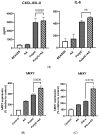Vitamin C Enhances Antiviral Functions of Lung Epithelial Cells
- PMID: 34439814
- PMCID: PMC8394979
- DOI: 10.3390/biom11081148
Vitamin C Enhances Antiviral Functions of Lung Epithelial Cells
Abstract
Vitamin C is well documented to have antiviral functions; however, there is limited information about its effect on airway epithelial cells-the first cells to encounter infections. Here, we examined the effect of vitamin C on human bronchial epithelium transformed with Ad12-SV40 2B (BEAS-2B) cells, and observed that sodium-dependent vitamin C transporter 2 (SVCT2) was the primary vitamin C transporter. Transcriptomic analysis revealed that treating BEAS-2B cells with vitamin C led to a significant upregulation of several metabolic pathways and interferon-stimulated genes (ISGs) along with a downregulation of pathways involved in lung injury and inflammation. Remarkably, vitamin C also enhanced the expression of the viral-sensing receptors retinoic acid-inducible gene 1 (RIG-1) and melanoma differentiation-associated protein 5 (MDA-5), which was confirmed at the protein and functional levels. In addition, the lungs of l-gulono-γ-lactone oxidase knockout (GULO-KO) mice also displayed a marked decrease in these genes compared to wild-type controls. Collectively, our findings indicate that vitamin C acts at multiple levels to exert its antiviral and protective functions in the lungs.
Keywords: GULO-KO mice; ISGs; airway epithelial cells; antiviral responses; vitamin C; vitamin C transporters.
Conflict of interest statement
The authors declare no conflict of interest. The funding sponsors had no role in the design of the study, in the collection, analyses, or interpretation of data, in the writing of the manuscript, or in the decision to publish the results.
Figures







References
-
- Maulén N.P., Henríquez E.A., Kempe S., Cárcamo J.G., Schmid-Kotsas A., Bachem M., Grünert A., Bustamante M.E., Nualart F., Vera J.C. Up-regulation and polarized expression of the sodium-ascorbic acid transporter SVCT1 in post-confluent differentiated CaCo-2 cells. J. Biol. Chem. 2003;278:9035–9041. doi: 10.1074/jbc.M205119200. - DOI - PubMed
Publication types
MeSH terms
Substances
Grants and funding
LinkOut - more resources
Full Text Sources
Medical
Molecular Biology Databases
Research Materials

